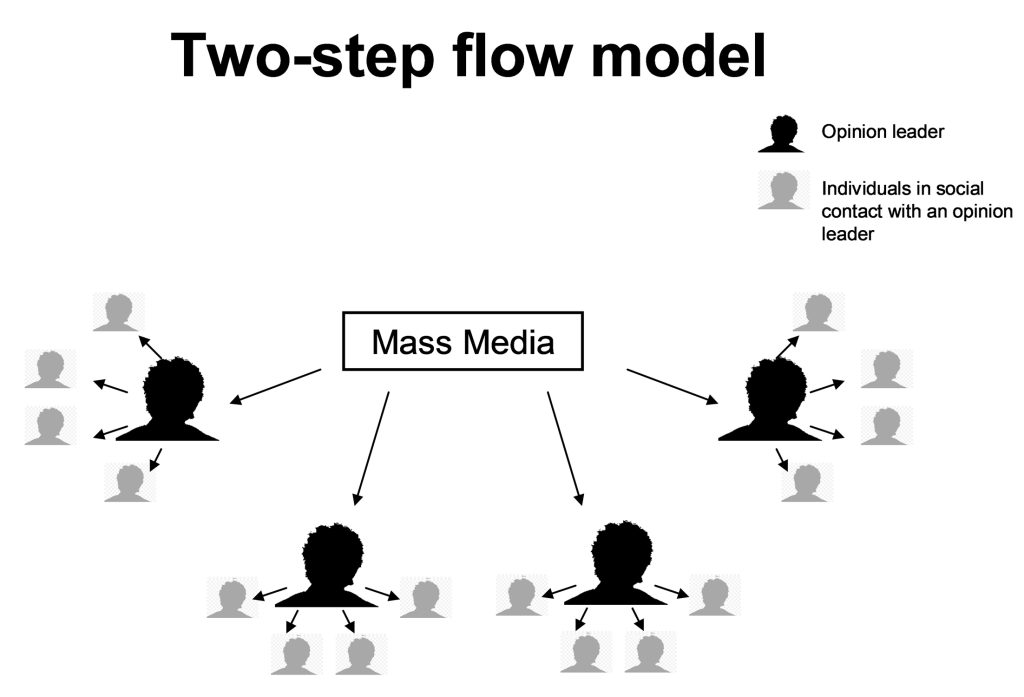In our fast-moving digital age, information travels quickly through many channels. However, how people understand and respond to media messages has been studied for many years. One important theory that helps explain this is the Two-Step Flow of Communication Theory, created in the mid-1900s by sociologists Paul Lazarsfeld and Elihu Katz. This theory changed how researchers think about media’s impact on public opinion and is still important in today’s connected world.
The Two-Step Flow Theory suggests that media does not impact the entire audience in the same way. Instead, its influence happens in two separate stages.
Media to Opinion Leaders: Mass media, including TV, newspapers, and social media, initially influences a select group called opinion leaders. These individuals actively engage with media content and have a better grasp of the messages, allowing them to analyse the information critically. Opinion Leaders to the Public: Next, these opinion leaders communicate their views and insights to a broader audience, often through personal interactions. The general public usually trusts these leaders, leading them to adopt similar opinions and attitudes on various topics.

The Importance of Opinion Leaders
Opinion leaders play a key role in the Two-Step Flow Theory. They are individuals who have more knowledge and interest in certain subjects, such as politics, fashion, health, or technology. These people are trusted by their peers and can shape the opinions and behaviors of those around them.
Interestingly, opinion leaders do not have to be well-known or in positions of power. They can be regular individuals with expertise in particular areas or a strong influence in their communities or social groups. In today’s digital world, opinion leaders often appear as bloggers, influencers, or content creators who share and explain media for their audiences.
Critiques and Development of the Theory
The Two-Step Flow Theory remains important, but it has received some criticism. A key point of concern is that it simplifies communication too much. Some researchers believe that media influence is more complicated, with information moving through various steps, feedback loops, or even direct effects in some situations. Moreover, in today’s media landscape, users can access news and information directly through tailored feeds, which questions the idea that people mainly depend on opinion leaders.
As a result, the theory has progressed into more detailed models like the Multi-Step Flow Theory, which considers the diverse and changing ways that information and influence can spread.
Why is the Two-Step Flow Theory Still Relevant Today?
The Two-Step Flow Theory is still important today. Originally created when traditional mass media was the main source of information, it fits well in our current world of social media and digital communication. Sites like Twitter, Instagram, and YouTube have increased the influence of opinion leaders, now called influencers, who share and shape content for their audiences.
Conclusion
The Two-Step Flow Theory is an important way to understand how media affects public opinion. It shows that personal connections and opinion leaders play a key role in how we make sense of media messages. Instead of getting information straight from the media, we often rely on trusted individuals to help us understand it.
In our current digital world, where influencers and online groups have significant impact, the Two-Step Flow Theory helps us see how communication and influence work.


Hi,
I really liked reading your post. I learned a great about the processes of the two step flow theory with a great understanding of some of the criticisms about it too. It was interested to read about the stakeholders involved in communication and media from media networks to politicians in power to social media figures, etc.
You give a good example of how the digital age and the Two Step Flow theory link together. You do this by talking about how the way media messages travels to consumers and how they have been studied for many years, people could interpret these messages differently into todays society as there is digital technology.
Additionally, you also talk about how theory is made up and a good insight is given to how The Step Flow Theory was created and who by.
Television, Newspapers and social media are used as mediums in the bloggers post, to show how The Two Step Flow Theory works. A strong discussion is talked about why opinion leaders are a good thing how they can shape opinions and behaviours trusted by their piers around them. However, you could give an example of how this is a good thing for fashion, politics, travel brands or news. For example, having a well-known influencer with lots of followers could help to sell a new fashion product, this is because opinion leaders create trust in their fans.
Finally, you talked about how the theory has had criticism and how some media influences are more complicated with information moving through various steps. The biggest thing, I disagree with you on is it’s a bad thing that users can access news via tailored feeds and not by opinion leaders. Opinion leaders can spread fake news.
This is particularly relevant when we consider the responses of platforms to dwindling trust, disinformation spread, and threats of echo chambers. Platforms are looking for technical solutions such as modifying the algorithms that prioritize and incentivize certain types of content and behaviours.
On the whole a really good post a few more examples linked to each point would have made it even better.